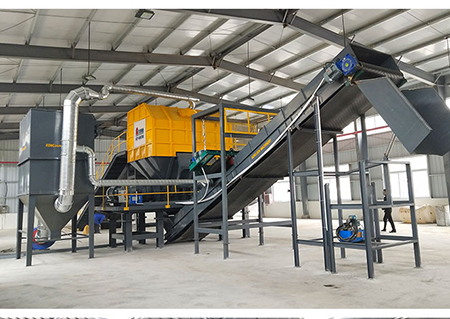
Tel/Whatsapp:+86 15649675999
Email:sale@kowloonmachine.com

Tel/Whatsapp:+86 15649675999
Email:sale@kowloonmachine.com
Article published:2024-04-06
What equipment is needed for agricultural waste recycling?
The recycling process from agricultural waste to biomass alternative fuel requires the use of chain plate conveyors, dual-shaft biomass crushers, magnetic separators, belt conveyors, hydraulic balers, pulse dust collectors and intelligent control systems. If the crushed agricultural waste is to be made into pellets, a single-shaft crusher, uniform feeder and biomass pellet machine are also needed.
The twin-shaft biomass crusher has an ultra-large capacity crushing area, which can carry oversized straw and rice straw; the cutter is made of imported high-alloy steel material, which has good wear resistance; the main shaft is also made of high-strength alloy steel, which has high mechanical strength. It has strong fatigue resistance and impact resistance; the inner hole of the tool and the spindle are designed with an inner hexagon, which has good torque transmission effect; the motor, reducer, etc. are also selected from well-known brands, with guaranteed quality and safer use.

Twin shaft biomass crusher
The hydraulic baler uses a hydraulic power system, which can quickly compress and pack agricultural waste, significantly reduce the volume of agricultural waste, and facilitate storage and transportation. There are two operating modes: manual or automatic. It is easy to learn and maintenance is also quite simple. You only need to regularly check the oil line and manage debris.
Hydraulic baler
The biomass pellet machine can solidify and shape loose agricultural waste into high-density pellet fuel, which not only makes transportation and storage easier, but also greatly improves its combustion performance, with high calorific value, high volatile matter, low sulfur content, and pollution Small, it can replace firewood, raw coal, fuel oil, liquefied gas, etc., and is widely used in heating, domestic stoves, hot water boilers, industrial boilers, biomass power plants, etc.
Energy utilization of agricultural waste
The energy utilization of agricultural waste has shown great potential in two aspects: fermentation and pyrolysis.
Using organic waste such as livestock manure and crop straw as raw materials, biogas rich in methane can be produced through anaerobic fermentation. This biogas can not only be used as fuel for daily lighting, but can also be widely used in greenhouse cultivation, vehicle gas, chick hatching, and power generation. Research has found that when a variety of wastes such as livestock and poultry manure, crop straws, vegetable and fruit residues are mixed and fermented, the gas production is significantly improved compared to the fermentation of a single waste.
In the field of pyrolysis, agricultural waste also shows great conversion value. The first is straw power generation. The fuel calorific value of 1 ton of straw with a moisture content of less than 14% or 2 tons of fresh straw is equivalent to 1 ton of standard coal. The development of straw power generation is an effective way to alleviate the energy shortage problem in rural areas. The second is straw gasification, which uses the principle of biomass thermal energy gasification to produce gaseous fuels containing hydrogen and carbon monoxide that are easy to transport, high grade, and highly utilized. The third is biomass fuel, which uses waste materials such as straw, rice husk, and wood chips to be processed into blocks through crushing, extrusion and other technologies, and then directly used for boiler combustion. The final pyrolysis liquefaction technology can process the liquid into organic chemical products such as biodiesel and biogasoline.
Energy utilization of agricultural waste
In the process of biomass fuel preparation, Kowloon processes agricultural waste into Biomass fuel that meets combustion requirements, this fuel can not only replace coal combustion, but also has less environmental pollution. This method of energy utilization not only increases the added value of agricultural waste, but also provides new solutions to rural energy problems. It also helps reduce environmental pollution and achieve sustainable development.